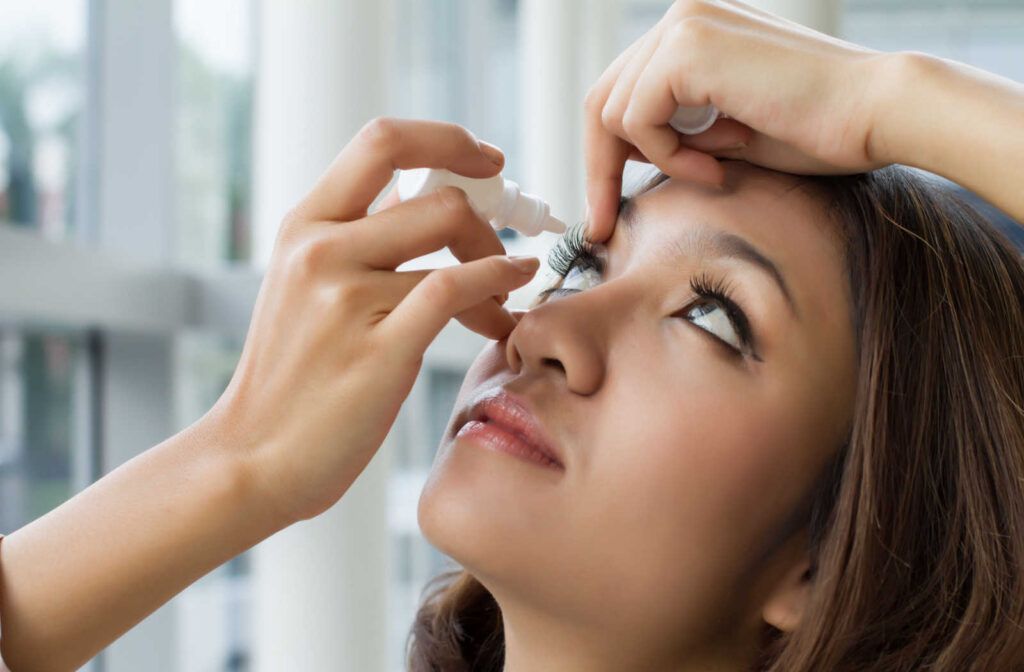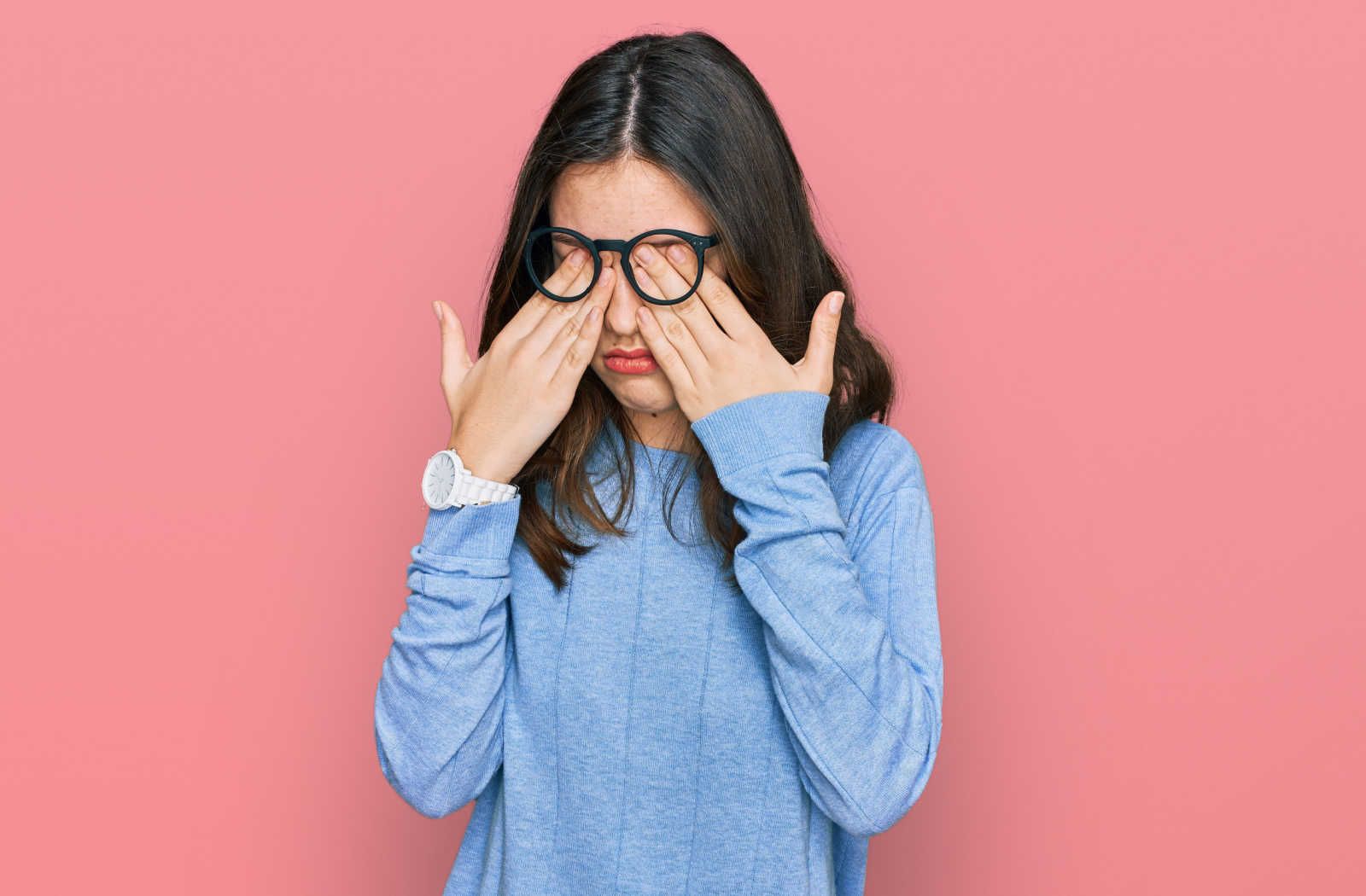Do you notice eye dryness, irritation, and discomfort, either when you’re indoors or outdoors? These symptoms may be from multiple factors affecting your eye’s ability to produce tears or an eye condition called dry eye.
When you visit your eye doctor for an eye exam, depending on the cause, they will determine a treatment plan based on your individual needs. Let’s talk about everything related to dry eye.
What Is Dry Eye?
Dry eye is a condition in which the eyes do not produce enough tears or tears evaporate too quickly because of an imbalance in the tear film, which has 3 layers:
- The outer oil layer keeps the eye’s surface smooth and prevents tears from evaporating.
- The middle water or aqueous layer protects the eye and keeps it hydrated.
- The inner mucous layer helps tear film stick to the eye’s surface.
Without sufficient tears or quality tears, the eyes don’t receive enough lubrication or moisture, leading to dryness, irritation, and sometimes complications.
Symptoms of Dry Eye
Symptoms of dry eye can be mild or severe and can include the following:
- Stinging or burning
- Scratchy or gritty sensation in your eyes
- Stringy mucus in or around your eyes
- Sensitivity to light
- Eye redness
- Difficulty wearing contact lenses
- Difficulty with nighttime driving
- Watery eyes or reflex tearing
- Blurred vision
- Eye fatigue
Multiple Causes of Dry Eye
Multiple causes of dry eye can affect the production of tears or increase the evaporation of tears. These include:
- Age: As we get older, our eyes naturally produce fewer tears.
- Medical conditions: Dry eyes can be a symptom of certain medical conditions such as rheumatoid arthritis, lupus, and Sjogren’s syndrome.
- Medications: Certain medications, such as antihistamines, birth control pills, and antidepressants, can cause dry eye as a side effect.
- Gender: Hormonal changes in women during pregnancy or menopause can lead to dry eye.
- Environmental factors: Dry, windy, or smoky environments can cause dry eye. Prolonged use of the computer or other digital screens can also cause dry eye because you blink less often.
- Lifestyle habits: Contact lens wearers, people low in omega-3 fatty acids, have a vitamin A deficiency or have had refractive eye surgery.
- Meibomian gland dysfunction (MGD): The oil-producing glands in the eyelids become clogged, leading to an altered tear film composition.
Diagnosing & Treating Dry Eye
During an eye exam, your eye doctor can diagnose meibomian gland dysfunction using Meibox imaging technology. It can capture high-definition images of the tiny oil-producing glands in your eyelids using infrared light. Early detection of the underlying cause of dry eyes allows for prompt treatment and relief of symptoms.
Based on the severity of your dry eye, your eye doctor can recommend one or more therapies to relieve dry eye symptoms and treat the underlying cause. Common treatments for dry eye can include:

Artificial Tears
Over-the-counter preservative artificial tears can provide temporary relief of dry eye symptoms. They come in various forms, such as drops and ointments.
Prescription Medication
If over-the-counter artificial tears don’t provide enough relief, prescription medication with ingredients such as cyclosporine (Restasis) or lifitegrast (Xiidra) helps to increase tear production.
Heat Mask
For mild cases of MGD, a specialized iMED microbead heat mask, compared to a warm compress, can deliver heat more evenly and effectively to unblock the oil-producing glands in the eyelids and improve tear production.
Lifestyle Changes
Changes in lifestyle to protect your eyes and prevent dry eyes can include:
- Avoid dry, windy, or smoky environments.
- Take regular breaks when working on a computer or other digital screens.
- Getting special contact lenses for dry eyes.
Omega-3 Supplements
Omega-3 oil supplementation is beneficial in reducing dry eye symptoms. Speak to your eye doctor first before taking any supplements,
Radiofrequency for Dry Eye
Radiofrequency or heat technology can treat all stages of MGD. The Tempsure envi is a non-invasive treatment therapy that can deliver gentle heat much deeper to unclog meibomian glands by melting the clogged oils.
For maximum benefits and more relief, 3 treatment sessions are recommended, with sessions taking about 15 minutes per eye. In severe cases of dry eyes caused by MGD, you can control symptoms by having annual maintenance sessions.
Much-Needed Dry Eye Relief
You don’t have to live with the discomfort of dry eyes. When you consult the eye doctors at Spectrum Eye Care, we can diagnose the cause of your dry eyes and provide options for relief.
Sometimes, a combination of treatments may be necessary to manage your dry eye symptoms. Don’t let itchy, dry, irritated eyes come between you and life. Schedule an appointment today.

